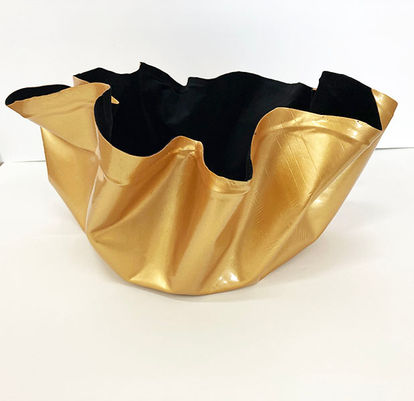SPRING/BREAK ART SHOW 2022: NAKED LUNCH, NEW YORK
LEFTOVER AND OVER
My golden drapes were featured in Leftover and Over, an exhibition that was part of SPRING/BREAK Art Show 2022: Naked Lunch, September 7-12. Here is an excerpt from the curatorial statement by Dr. Giovanni Aloi:
What does the historical aftermath of Manet’s Luncheon on the Grass (1863) look like? Leftover and Over offers a contemporary glimpse into the same woods in l’île Saint-Ouen, on the River Seine. In essence, Luncheon on the Grass is a painting about patriarchal voracity—the insatiable consumption of the gaze, the relentless extractionism of toxic masculinity, and the unquenchable desire that only sex and food can instill in us. Today as we come to terms with the idea that atmospheric pollution is not just the result of reckless fuel carbon burning but also of patriarchy and its related logic of conquest and subjugation. Since the dawn of the industrial revolution, over and over, we have devoured, depleted, and discarded natural resources as if they were endless and as if nature were nothing more than an idyllic backdrop against which to frivolously frolic.
The perspective of Luncheon on the Grass casts the viewer as a casual voyeur who has arrived late to the picnic—the sex has already happened and not much food is left either. Everything, it seems, was consumed in haste. This enigmatic composition reveals the naked truth beneath the hypocrisy of Parisian audiences that would find no problem gazing at the nude body of a Venus but that squirmed in disgust at the sight of the everyday French life they led. Leftover and Over metonymically mirrors Luncheon on the Grass while critically addressing the nature, purpose, and outcomes of the voracity that makes it so haunting and revealing.
In Leftover and Over, Bodzy’s golden veils appear as reimaginations of Manet’s picnic blankets—the 19th century take on Venus’ drapes of modesty and decorum—into emotionally charged and vibrant visualizations of vulnerability, the aftermath of everyday traumas that still define women’s lives today. Thin and yet resistant, the veils allude to the vulnerability of women who, oppressed by patriarchal power, must conceal feelings and emotions beneath a veneer of objectified and appealing perfection. Bodzy’s work is biographical in essence but the aesthetic language she deploys allows viewers to find their place among the narrative outlines that hold every piece together. Each work is a meditation on the patriarchal logic of power and a feminist logic of pleasure shaped by resilience, vulnerability, and strength.








